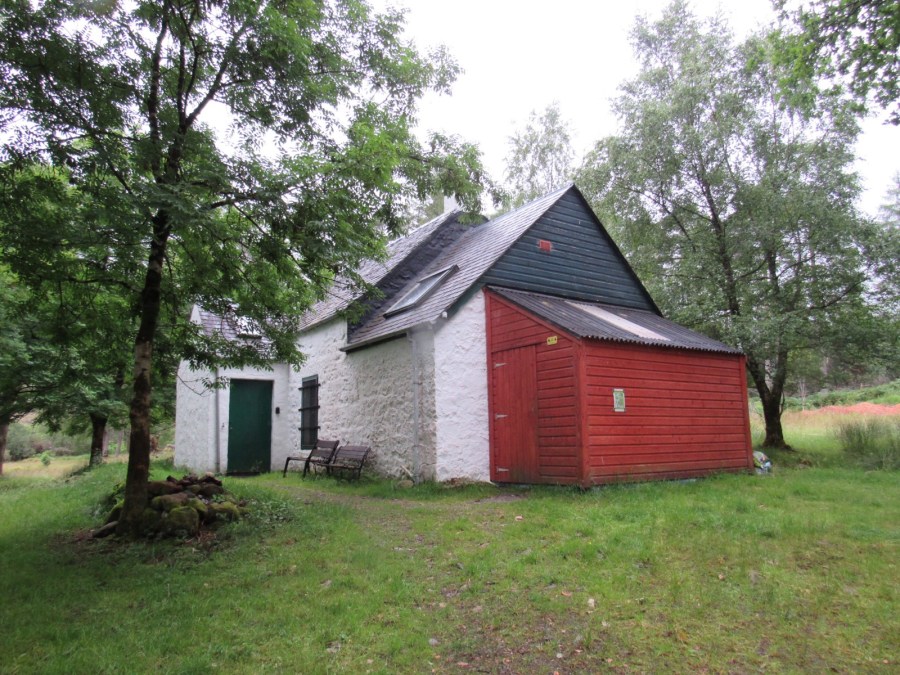The Grampian Club have objected to a hydro power scheme that would result in the water supply to an historic mountaineering hut becoming undrinkable
Since 1961, Dundee-based Grampian Club, which has 230 members, has run the former roadmen’s hut known as Inbhirfhaolain, Glen Etive. They puchased the property and grounds in 1991, and the hut is hired out at a cost of only £6 per person per night. It’s estimated that during the last seven years it has attracted an occupancy of over 4,500 bed nights, providing a boost to the local economy.
The hut’s sole water supply is from the nearby Allt Fhaolain burn at a designated collection point. The Grampian Club say this is a feature which appeals to many visitors who favour a simple approach to enjoying the mountain environment – not unlike bothy life.
But now, one of the proposed Glen Etive hydro schemes threatens that water supply and would make it unfit for human consumption.
“The hydro power scheme threatening our property is one of no fewer than seven schemes proposed by Dickins Hydro within an 11km stretch of Glen Etive, which is part of the Ben Nevis Glen Coe National Scenic Area”
Speaking for the Club, spokesperson David Gibson said: “The proposed scheme is a direct threat to this unique, low-cost accommodation which will be uninhabitable if the scheme goes ahead. Neither the developer nor its contractors have contacted the Club nor have they made any assessment of impacts on occupancy resulting from changes to the water supply. They have not considered the broader issues arising from the scheme which would affect the amenity of the hut, which has provided low cost accommodation for climbers and hill walkers in Glen Etive for almost 60 years.
“If this scheme goes ahead, it is obvious that people will no longer be able to use the accommodation, and our members stand to lose the value of the property and its income, which is in any case reinvested in the property. The property may well be a write-off.
“The hydro power scheme threatening our property is one of no fewer than seven schemes proposed by Dickins Hydro within an 11km stretch of Glen Etive, which is part of the Ben Nevis Glen Coe National Scenic Area. If approved, these schemes would have a significant visual and physical impact on the wild land and amenity of the glen for walkers, climbers, photographers and canoeists and we hope that The Highland Council will exercise appropriate judgement in its assessment of the planning applications.”
The proposed Glen Etive hydro schemes
Here are the seven proposed hydro schemes set to go ahead in Glen Etive:
- Allt Fhaolain, Grampian Club objection (18/02740/FUL)
- Allt Charnan (18/02738/FUL)
- Allt Ceitlein (18/02739/FUL)
- Allt Mhuiran (18/02741/FUL)
- Allt Chaorainn (18/02742/FUL)
- Allt nan Gaorean (18/03024/FUL)
- Allt a’ Bhiorain (18/03026/FUL)
The Grampian Club’s full objection
The Club’s objection to Planning Application 18/02740/FUL for the “Construction of a run-of-river hydro power scheme, abstract water from the Allt Fhaolain burn and pipe to a turbine” is made on 5 different grounds:
A. No Prior Notification and Consultation
Despite its tenure of 57 years the Club has not received any approach from the applicant, Dickins Hydro Resources Ltd. of London or its contractors. Given the importance of the Hut to the Scottish and wider mountaineering community, the Club believes that the lack of consultation is either because the applicant has not undertaken sufficient research into the proposed scheme, or that they simply wish to maintain secrecy in the hope that it will not come to the notice of those directly affected
B. The disruption to, and viability of, the Hut’s water supply
The applicant states that during construction the flow in the river can be expected to be disrupted for periods of time, but has not considered the impact on occupancy of the Hut. The risk of contamination during construction is stated in the application and the Club is concerned about this and the ongoing agitation of the water which will be unfit for human consumption, with significant consequences for occupancy of the Hut and its financial viability. Had the applicant bothered to establish the water source for the Hut this would have been obvious.
C. The noise from the power house turbines will be constant
The proposed location is a secluded glen where any noise is noticeable, especially a constant mechanical noise, and even more so in the evenings, a time of day when Hut occupancy is at its peak. Any noise from the turbines will detract considerably from the amenity and enjoyment of visitors to the Hut, leading to a decline in occupancy and income as the deterioration in the Hut’s established reputation and amenity become widely known.
D. The visual impact of the power house, associated facilities and the hard standing
The power house will have the appearance of an industrial facility, one in view from the Hut and the Glen Etive road, and as such, totally unsuited to its surroundings. It will be just over 100m away from the Hut, and result in a significant further deterioration from the amenity currently enjoyed by occupants
E. Right of access to water and obligations of the landowner
The Hut title deeds state that the Club has ‘a right of access to the water supply system the location of which is not known, together with access thereto for the purposes of maintenance repair and renewal’. This provides the Club with a right of access beyond the boundaries of its land to the Hut water supply, which can only be the Allt Fhaolain, as there is no other source and never has been.








